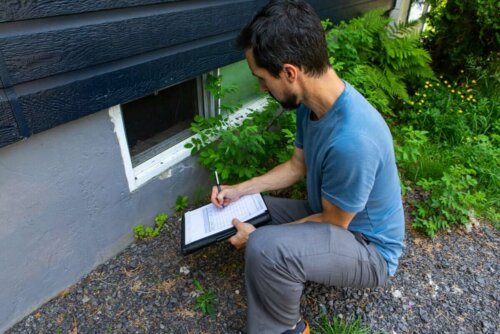Can Mold in the House Lead to Health Problems?

The presence of mold in the house causes problems that could go beyond structural damage. Its odor and stains on walls and ceilings are particularly noticeable. In fact, this kind of fungus may become the cause of health problems in the long run.
According to information published by the Centers for Disease Control and Prevention, exposure to damp and moldy environments leads to allergies and respiratory deficiencies in some people. Also, it can trigger a crisis in people with asthma.
What exactly is the mold?
As we said above, this is a type of fungus that grows both indoors and outdoors. It usually appears in areas of high humidity, such as roofs or walls where water leaks in windows, pipes, or in any place where there’s frequent contact with liquids.
Similarly, it grows on cardboard elements, wood products, drywall, carpets, and paint. The spores float and easily spread through the air. Then, the mold thrives and grows if the environment is warm and humid.
According to an article in the Environmental Health Perspectives journal, there are about 500 species of fungi that are harmful to human health. However, the most common indoor types of mold are Cladosporium, Penicillium, and Aspergillus.

Check out these Four Solutions to Get Rid of Mold in Your Bathroom
Types of mold
We don’t know exactly how many types of mold there are in the world. Some suggest there may be 100,000, while others state there are 300,000 or more. In any case, about 500 have been identified as potentially harmful to people. Of these, the best known are:
- Alternaria belongs to the ascomycete fungi genus and tends to develop in damp places around the house such as the shower or under leaky sinks.
- Aspergillus is a mold that can grow indoors, on dust, on food, or in building materials. It often leads to allergies and could even be toxic and lead to swelling and breathing problems.
- Cladosporium is a fungus that grows in both cold and warm areas. It usually grows on fabrics and wood surfaces and also causes allergies.
- Penicillium has a blue or green surface and a velvety texture. It usually grows in buildings or houses damaged by water and also in carpets, wallpapers and mattresses. Its presence in the home increases the risk of respiratory diseases.
- Acremonium is a mold with a characteristic pink, gray, orange, or white tone. It usually grows in areas such as condensation from humidifiers, drainage trays, and window sealants. It’s one of the most dangerous species, associated with bone marrow and immune system diseases.
How does mold get into the house?
Mold spores are present both indoors and outdoors but aren’t visible to the naked eye. In either case, these go into a house through windows, open doors, ventilation ducts, or air conditioning and heating systems.
They may also stick to objects, such as clothing and shoes, and then sneak indoors with the person who’s wearing them. Also, they often catch a ride in a pet’s fur. The mold will grow if the right humidity conditions exist inside a home; it won’t cause any problems otherwise.
Mold and health problems
The presence of mold in the house isn’t usually a problem unless the spores come into contact with damp spaces and begin to grow. There’s a real health risk when this happens, especially if the inhabitants of a house have preexisting respiratory or immune system conditions.
Possible allergies
Mold growth in the home can worsen the symptoms of anyone with allergies. Specifically, it triggers symptoms such as nasal congestion, itchy nose and throat, sneezing, watery eyes, and excess mucus.
Also, early exposure to molds or moisture appears to increase the risk of asthma and rhinitis. At least according to a study published in the Allergy journal.
Increased risk of respiratory disease
Also, molds are associated with other respiratory care diseases besides allergies. The research reported in the Environmental Health magazine determined that residential humidity and mold significantly increase the risk of respiratory infections, such as bronchitis and also with:
- Hypersensitivity pneumonitis
- Allergic alveolitis
- Chronic rhinosinusitis
- Sinusitis
- Lower respiratory tract problems in previously healthy children
Aspergillosis
Contact with Aspergillus mold can lead to a serious illness known as aspergillosis. This can cause a severe infection that can even spread to other parts of the body. Its symptoms range from chronic cough to coughing and bleeding, fever, wheezing, and weight loss. It could also manifest as:
- Bone pain
- Chest pain
- Chills
- A decrease in urinary volume
- Headaches (headache)
- Respiratory insufficiency
- Visual impairment
- Skin lesions

How to prevent health problems caused by mold in the house
Of course, there are several measures to prevent mold and keep it from risking your health. One of the most important ones is to ensure clean, ventilated, and moisture-free spaces. In this regard, the Environmental Protection Agency (EPA) suggests looking for a humidity level below 60%.
Other recommendations are:
- Fix any leaks and dry any water spills immediately.
- Install a dehumidifier to reduce indoor humidity.
- Open windows to allow air to circulate.
- Install an exhaust fan to absorb moisture during cooking.
- Avoid drying clothes indoors.
- Empty and ventilate cupboards, especially if you don’t use them often.
- Regularly clean all surfaces that are susceptible to mold such as walls, ceilings, furniture, etc.
- Use anti-mildew products to disinfect the bathroom and other rooms exposed to humidity.
- Call a professional to solve any structural problems that facilitate the presence of mold.
You may be interested in some Effective Ways to Remove Mold from Your Washing Machine
Consulting a doctor is important when there’s mold in the house
Mold exposure doesn’t always cause health problems. Still, the best preventive measure is to prevent it altogether. Consult a doctor if you have symptoms of allergies or respiratory deficiencies. You mustn’t ignore them, as they could lead to serious complications.
Keep in mind that mold isn’t always the cause of disease but can worsen other preexisting conditions. Thus, you must follow the recommendations of a professional to solve any problems of dampness as soon as possible.
All cited sources were thoroughly reviewed by our team to ensure their quality, reliability, currency, and validity. The bibliography of this article was considered reliable and of academic or scientific accuracy.
- Basic Facts about Mold and Dampness. (August 11, 2020). Centers for Disease Control and Prevention.
Available in https://www.cdc.gov/mold/faqs.htm - Weinhold B. A spreading concern: inhalational health effects of mold. Environ Health Perspect. 2007;115(6):A300-A305. doi:10.1289/ehp.115-a300
- Meena M, Gupta SK, Swapnil P, Zehra A, Dubey MK, Upadhyay RS. Alternaria Toxins: Potential Virulence Factors and Genes Related to Pathogenesis. Front Microbiol. 2017;8:1451. Published 2017 Aug 8. doi:10.3389/fmicb.2017.01451
- Bandres MV, Modi P, Sharma S. Aspergillus Fumigatus. [Updated 2020 Aug 10]. In: StatPearls [Internet]. Treasure Island (FL): StatPearls Publishing; 2020 Jan-. Available from: https://www.ncbi.nlm.nih.gov/books/NBK482464/
- Bensch K, Braun U, Groenewald JZ, Crous PW. The genus Cladosporium. Stud Mycol. 2012;72(1):1-401. doi:10.3114/sim0003
- Egbuta MA, Mwanza M, Babalola OO. Health Risks Associated with Exposure to Filamentous Fungi. Int J Environ Res Public Health. 2017;14(7):719. Published 2017 Jul 4. doi:10.3390/ijerph14070719
- Schell WA, Perfect JR. Fatal, disseminated Acremonium strictum infection in a neutropenic host. J Clin Microbiol. 1996;34(5):1333-1336. doi:10.1128/JCM.34.5.1333-1336.1996
- Mendell MJ, Mirer AG, Cheung K, et al. Health effects associated with dampness and mould. In: WHO Guidelines for Indoor Air Quality: Dampness and Mould. Geneva: World Health Organization; 2009. 4. Available from: https://www.ncbi.nlm.nih.gov/books/NBK143940/
- Thacher JD, Gruzieva O, Pershagen G, et al. Mold and dampness exposure and allergic outcomes from birth to adolescence: data from the BAMSE cohort. Allergy. 2017;72(6):967-974. doi:10.1111/all.13102
- Sharma BB. Molds and the lungs. Lung India. 2010;27(4):194-195. doi:10.4103/0970-2113.71937
- Fisk WJ, Eliseeva EA, Mendell MJ. Association of residential dampness and mold with respiratory tract infections and bronchitis: a meta-analysis. Environ Health. 2010;9:72. Published 2010 Nov 15. doi:10.1186/1476-069X-9-72
This text is provided for informational purposes only and does not replace consultation with a professional. If in doubt, consult your specialist.








